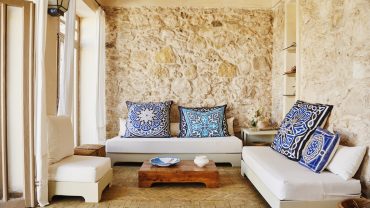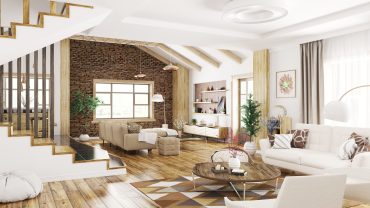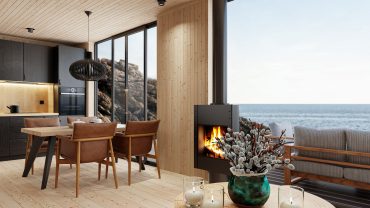Whether it’s a lazy Sunday stretched across the sofa or a lively evening with friends, the living room is the place to gather, have fun, and unwind. A minimalist living room design is the perfect backdrop for all these life moments and more. By keeping things simple and pared back, it creates spaces as stylish as they are serene.
Sofa so good. But how does one achieve this brand of effortless elegance? And what’s the trick to getting it right? Read on, as we explore just that, with plenty of practical minimalist living room ideas to inspire.
What is Minimalist Design?

Minimalist living room (Credit: SARMDY via Getty Images)
Before settling down to explore minimalist living room ideas, let’s get to grips with the style itself. A core characteristic of minimalism is simplicity; simple shapes, clean lines, neutral colours, and open layouts. This is sometimes phrased as “less is more” but is somewhat of an oversimplification. Yes, minimalism is about stripping things back to create a sense of calm, but it’s not about ridding a room of things. Rather, it’s about deliberate curation; about carefully choosing to keep only those elements that contribute something, whether that be functional or stylistic, ideally both.
With fewer decorative components and a pared-back approach, some might expect a minimalist lounge to feel cold or stark. Yet when designed with care, the opposite is true. A minimalist sitting room embraces warmth through natural textures, layered lighting, and meaningful details. The result is a space that feels open, intentional, and quietly inviting. So, how is this all done? Let’s take a look.
Less Furniture, More Functions

Stylish space with subtle storage (Credit: gerenme via Getty Images)
Nothing exemplifies doing more with less quite as elegantly as multifunctional furniture. From benches that double as storage to sideboards that expand into dining tables, each item works harder and achieves more.
A good example of such multifunctional potential is the coffee table. In addition to serving as a surface for drinks or decorative items, many contemporary designs feature built-in drawers, shelves, or hidden compartments, perfect for reducing clutter. Some models also include lift-top mechanisms, allowing the tabletop to be raised to a convenient height for dining, working, or other activities. Combined, these features can transform a simple table into a hidden home office. Other variations take a modular approach, incorporating integrated stools that can be tucked away when not in use.
Behind Closed Doors

Behind closed doors (Credit: Michael Robinson via Getty Images)
Built-in cabinetry, floating shelves, and dual-purpose furniture are all hallmarks of minimalist lounge design, offering discreet solutions to conceal the clutter of daily life. Among these, modular furniture stands out for its exceptional versatility.
Whereas traditional storage tends to be static in both size and form, modular systems embrace a dynamic, mix-and-match philosophy. Comprised of interconnected, customisable units, they can be arranged and reconfigured in countless ways, allowing for the best use of available space. This capacity to rearrange components also makes them incredibly adaptable to changing needs over time, reducing the need to replace furniture.
Colour With Quiet Impact

Stunning colour accents in a minimalist living space (Credit: imaginima via Getty Images)
The minimalist sitting room colour palette is one of largely neutral tones. And with good reason. For one thing, lighter hues reflect natural light with ease, helping a space feel brighter, larger and airier, thus cultivating a sense of openness and serenity. What’s more, a neutral base offers the ideal foundation for layering in texture, form, and carefully considered accents.
The colours that tend to come to mind in this context are whites, beiges, greys, and taupes. And yet they are far from the only options. The trick is to work with a single colour family, playing with tonal variations to introduce depth. For instance, a soft palette of pale green, warm brown, and gentle beige brings a hint of the outdoors in, evoking woodland calm without overwhelming the senses.
Tactile Decor

Tactile touches in a modern living room (Credit: asbe via Getty Images)
So far, we’ve seen that minimalist lounge ideas focus on sleek lines and seamless surfaces. Introducing texture into the mix offers an inviting contrast to all that smoothness. It imbues the space with warmth, depth, and visual intrigue. And all without disrupting the aesthetic. Whether it’s soft luxurious wool-blend curtains, delightfully fuzzy velvet cushions, or decadence in the form of a high-pile rug, the simplest way to add tactile touches is through soft furnishings. But there’s plenty more opportunity where that came from. The walls alone offer myriad options, from textured wallpaper or specialist paint to bare brick.
Positively Negative Space

The positivity of empty space (Credit: Westend61 via Getty Images)
We’ve been looking at what to incorporate into a room design. But minimalist lounge ideas also incorporate a certain amount of unoccupied or empty space. This is known as negative space and involves leaving gaps, both on the floors and the walls. Overall, it reinforces the uncluttered feel, provides a visual break, and amplifies architectural details and material choices. With fewer visual interruptions, light drifts freely, textures sing softly, and design statements are granted the spotlight they deserve.
Artful Accents

Decorative wall art can add depth to a space (Credit: archigram via Getty Images)
The key to choosing artwork and decor for a minimalist living room design lies in restraint and intentionality. In other words, no random or excessive knick-knacks. Instead, decorative elements should be few and meaningful, chosen for their personal significance or purpose. This makes each piece stand out all the more. For example, there might be one large artwork or a small collection of meaningful pieces on otherwise bare walls to serve as a focal point, acting as a strong visual anchor.
Let the Light In

Maximum light, minimalist space (Credit: Robert Daly via Getty Images)
Natural light is perhaps the only thing enjoyed in abundance in a minimalist lounge design. As such, windows, skylights, and doors, all are designed to maximise its impact.
Once the sun is down, it’s a matter of striking a balance between form and function; about using subtle, unobtrusive fixtures which can blend seamlessly into the space while providing effective illumination. It’s also about diversity, using a mix of small fixtures, concealed light sources, and integrated illumination.
Defined Zones, Open Flow

Clean and uncluttered (Credit: Westend61 via Getty Images)
Minimalism favours open-plan layouts for their cohesive and uncluttered feel. But this approach can leave a space lacking definition. Using rugs, slender dividers, or lighting changes are just some of the ways to insert subtle delineations. Differing floor finishes are a powerful example of this technique. So, in an open plan kitchen-living area, there could be two distinct flooring choices to distinguish zones.
Plant Life With Purpose

Plants with a purpose (Credit: Interiors3D via Getty Images)
Nature finds a natural home in the world of minimalist living room ideas, adding organic contrast and a sense of tranquillity. In terms of indoor plants, larger varieties like fiddle-leaf figs or olive trees suit minimalist lounge design beautifully. For smaller spaces, trailing ivy or structured succulents nestled in ceramic pots offer a similar effect on a more modest scale. Or, for the ultimate multi-functional space saver, there’s the option of framed moss as wall art. Modern and striking, this can simultaneously serve as a style statement, incorporate nature, and add textural interest.
Technology, Quietly Integrated

Stunning integrated lighting in a minimalist living room (Credit: ShutterWorx via Getty Images)
Modern technology blends into minimalist living rooms with subtlety. Sound systems disappear into cabinets, televisions double as artworks, and cable management solutions maintain pristine sightlines.
Smart features such as motorised blinds or integrated lighting can bolster the convenience of minimalist lounge ideas without distracting from the design. Even charging points and Wi-Fi routers can be cleverly hidden, helping the space stay serene and gadget-friendly.
Living More With Less

Luxury meets minimalism (Credit: onurdongel via Getty Images)
In all, we’ve seen a range of minimalist living room ideas. Whether through streamlined furnishings or subtle textures, minimalist lounge design encourages a slower pace and deeper appreciation for one’s surroundings.












